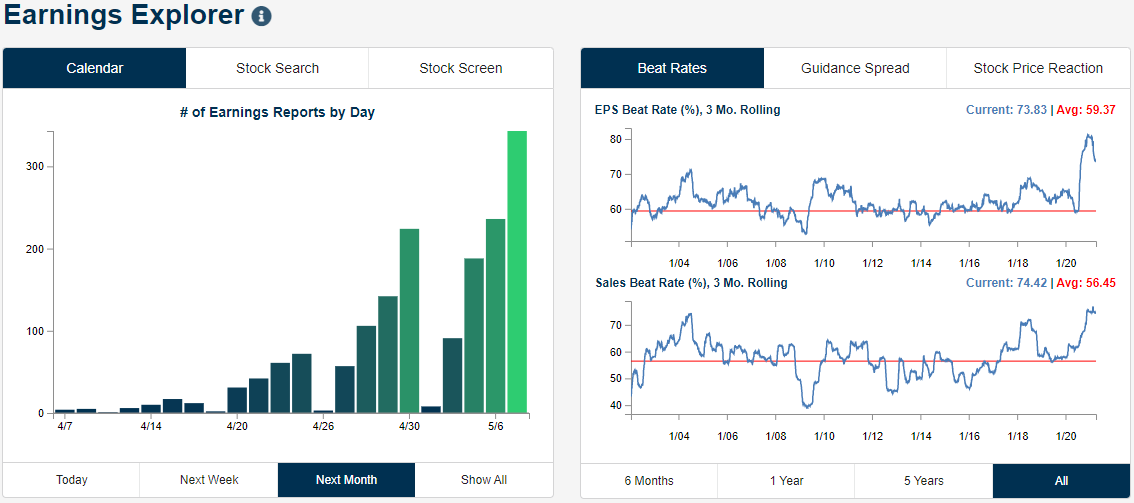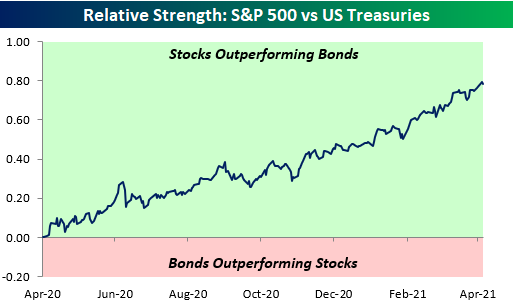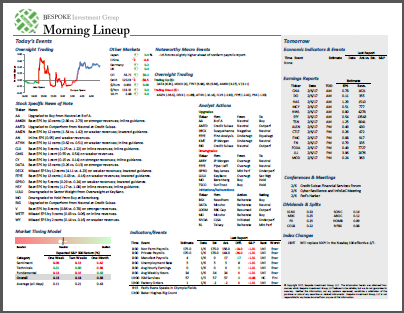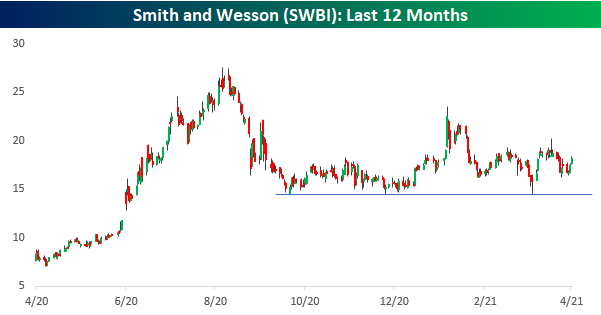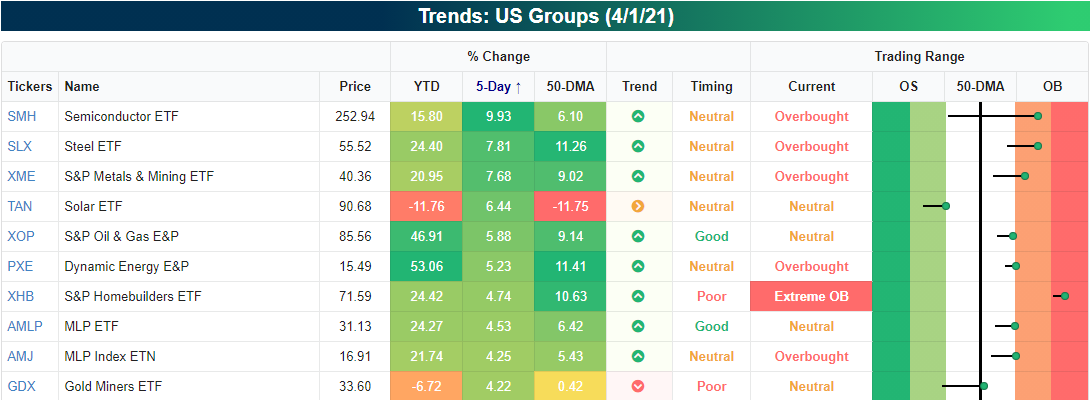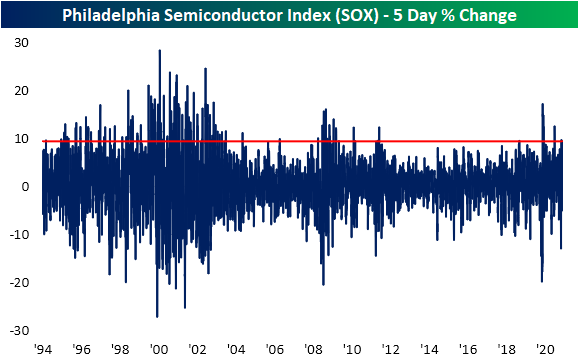Triple Plays Chart Update
The earnings calendar has been quiet, and it will remain that way until the second half of the month when the Q1 earnings season really kicks into gear. When it comes to earnings, the 3 month rolling EPS beat rate and guidance spread have pulled back significantly over the past few months. Granted, both of these as well as the sales beat rate remain at levels well above typical levels. As such, there have been a huge number of triple plays over the past three months, 268 of the total 2048 reporting companies to be exact. A triple play is when a company reports better than expected sales and earnings while also raising guidance. Typically, this can be viewed as a sign of fundamental strength for a company.
Looking over those triple plays, the average stock that has reported a triple play over the past three months rose over 3% on its earnings reaction day with 64% finishing the day in the green. That positive performance has tended to continue in the weeks after earnings although there have been some that have recently been consolidating. In the charts below, we show a handful of these. Some like Abbott Labs (ABT) and Perficient (PRFT) have been in short-term downtrends that have brought them back down to support around their 50-DMAs. Others like Analog Devices (ADI), Broadcom (AVGO), and Crocs (CROX) have been stuck under resistance over the past several weeks but have made attempts to break out in the past few days. For all of these, there has yet to be a decided move either to the up or downside.
While the names above have yet to break out of their consolidation ranges, there are a number of recent triple-plays that have successfully managed to break out to the upside. For a recap of those names, make sure to log in. If you aren’t currently a client, sign up for a free trial to one of Bespoke’s research offerings.
As Close to a Perfect Year For Equities as You Can Get
Every day in our Morning Lineup, we provide a technical snapshot of the market looking at various metrics. One chart we show is the relative strength of stocks (S&P 500) versus bonds (US Treasury Long Bond Future) over the trailing 12 months (chart below). Whenever the line is in the green area, it indicates that stocks are outperforming bonds relative to the start date, while readings in the red zone indicate bonds outperforming stocks. What stood out about the chart in this morning’s report was the fact that relative to one year ago (4/1 close), stocks have been outperforming bonds every day since. Sure, there have been periods in between where bonds outperformed stocks (falling line), but from a longer-term perspective, it has been about as perfect a year for stocks relative to bonds as you could imagine.
The chart below shows the performance of both asset classes individually over the last year. If you think the divide between political parties in the US has ripped wider, it has nothing on the growing divide between stocks and bonds. While the S&P 500 is up over 50%, the US Treasury Long Bond Future is down 14%. If we had to bet on which divide will start to narrow sooner, is there anything closer to a sure thing than taking the stock vs bond divide over the Democrat vs Republican divide? Click here to view Bespoke’s premium membership options for our best research available.
Bespoke’s Morning Lineup – 4/7/21 – The CEOs Speak
See what’s driving market performance around the world in today’s Morning Lineup. Bespoke’s Morning Lineup is the best way to start your trading day. Read it now by starting a two-week free trial to Bespoke Premium. CLICK HERE to learn more and start your free trial.
“The discipline of writing something down is the first step toward making it happen.” – Lee Iacocca
CEOs of two of the largest companies in the US are making headlines for recent comments this morning; one in a blog post and the other in his firm’s annual letter.
First, despite disagreement even within the Democratic caucus, Amazon CEO Jeff Bezos came out in support of the Biden Administration’s plan to boost investment in US infrastructure. Realizing the costs involved in such a plan, the Amazon founder noted in a blog post that “we’re supportive of a rise in the corporate tax rate.” While cynics would say that AMZN doesn’t pay corporate taxes so why should it care, we would note that the company has in recent years seen its tax bill go up as it has become more profitable. The rate is still very low, however, as in 2020, the company’s effective tax rate was 9.4%.
The second CEO making headlines this morning is JP Morgan Chase CEO Jamie Dimon. In the bank’s annual letter, Dimon expressed some concerns about potential inflation due to stimulus hitting the economy as it is already starting to rebound. That could lead to higher interest rates ‘making things a little worse’. In terms of equity valuations, he noted that they are high by ‘almost all measures, excect interest rates’. Therefore, higher interest rates to combat inflation could be problematic for the stock market. The high valuations, though, could be justified if the multi-year boom in the economy that he expects ‘could easily run into 2023’ comes to fruition.
Read today’s Morning Lineup for a recap of all the major market news and events including a recap of Composite PMI data for March, US and international COVID trends as well as our series of charts tracking vaccinations, and much more.
After a strong start to the quarter in its first two trading days, US equities took a breather yesterday from what was and still is an extreme overbought condition. As shown in the chart below, the S&P 500 was more than 2.5 standard deviations above its 50-day moving average heading into yesterday’s trading, which was not only the most extreme overbought reading in the last year but also the most overbought level since February 2017. Extreme overbought readings don’t mean that the market has to immediately sell off, but it often suggests that a rally is due for a pause.

Precious Metals Finding Support and Eyeing Breakouts
After a strong run in the first months of the pandemic, gold (GLD) has been in a downtrend since the summer erasing most of the past year’s move higher. While GLD is far from breaking its longer-term downtrend, the past few weeks have at least seen a bit more constructive price action with a potential double bottom forming. After trading deep into oversold territory in early March, GLD found at least a temporary bottom right around the lows of last sping’s range. Last Tuesday, there was another successful retest of those same support levels. Since then, GLD has pressed higher and is getting close to breaking out of the past few weeks’ consolidation range.
Elsewhere in the precious metals space, silver (SLV) has generally fared better over the past several months. While it hasn’t been pressing higher either, SLV has more or less been trending sideways since last summer’s high. Since late February, SLV had been heading back to the bottom end of its range, but like GLD, it recently found some support. SLV took a brief dip below its 200-DMA one week ago which snapped a streak of 217 consecutive closes above its long-term moving average; the third-longest on record since SLV began trading in 2006 as shown in the second chart below. That drop below did not last long though as SLV has since moved back above its 200-day. Now, it is sandwiched between its 200-DMA and 50-DMA; which it had previously failed to move above last month. Additionally, the move higher today is breaking the short-term downtrend that has been in place for most of 2021. Like gold, the overall longer-term picture for silver has a lot of room for improvement, but at least in the near term, there are some positives developing in the past week. Click here to view Bespoke’s premium membership options for our best research available.
Bespoke’s Morning Lineup – 4/6/21 – All Quiet on the Market Front
See what’s driving market performance around the world in today’s Morning Lineup. Bespoke’s Morning Lineup is the best way to start your trading day. Read it now by starting a two-week free trial to Bespoke Premium. CLICK HERE to learn more and start your free trial.
“How did you go bankrupt?”
“Two ways. Gradually, then suddenly.” – Ernest Hemingway, The Sun Also Rises
With little in the way of economic data today and earnings season not really kicking off until next week, it’s a quiet morning. Futures are modestly lower even as the 10-year yield is back below 1.7%. After being closed yesterday, European markets are back open this morning and making up for lost time by rallying in reaction to the strength in the US yesterday.
In SPAC news, NFTs may be the hot trend in the collectible space, but traditional baseball cards are the center of attention this morning as Topps has announced a deal to go public in a merger with Mudrick Capital. The deal for the maker of cards for baseball, most other major sports, and who can forget- Garbage Pail Kids- will be valued at $1.3 billion. You can also bet that at some point, they will be moving into the NFT space. Perhaps the most telling aspect of the SPAC environment these days is the fact that in an interview with Topps Chairman Micheal Eisner, he stressed that the company will be operating as a ‘real’ company.
Read today’s Morning Lineup for a recap of all the major market news and events including the latest Australian Central Bank decision, a recap of SENTIX investor sentiment surveys for April, US and international COVID trends as well as our series of charts tracking vaccinations, and much more.
The market may be quiet this morning, but there have already been plenty of fireworks to start the second quarter. While the two 1% gains came four calendar days apart, this is the first time that the S&P 500 has kicked off a new quarter with back-to-back 1%+ gains since Q2 2009! As shown in the table below, in the post-WWII period, there have only been seven other quarters that kicked off with back-to-back gains of at least 1%.
The table below shows the S&P 500’s performance in the week after each of those prior strong starts as well as its performance over the rest of the quarter. Over each of the time periods, the S&P 500 saw positive returns on both an average and median basis, and while the S&P 500 was up for the remainder of the quarter following each of the last four occurrences, in the three occurrences prior to 1987, it was down over the remainder of the quarter every time.

Another Record in Gun Background Checks
It seems to happen every month these days, so it shouldn’t come as much of a surprise that FBI background checks for the purchase of firearms hit a new record in March, rising by more than a million to 4,691,738. It used to be that background checks followed a relatively steady saw-tooth seasonal pattern where, as shown in the chart below, they would fall throughout the first half of the year, bottom out in mid-Summer, and then steadily rise throughout the second half of the year. That seasonal trend became less consistent in the early part of the last decade and has completely broken down in the last two years. Now, it seems that the monthly number of background checks goes in one direction – up!
Despite rising to new record highs, the pace of growth in background checks has started to slow down a bit. March’s growth rate was 25.4%, and while that is still an extremely rapid rate of increase, it’s at the low end of the range from the last year where the y/y change in checks peaked out at 79.2% last July in the midst of the nationwide protests around the country. Click here to view Bespoke’s premium membership options for our best research available.
Just as the stock market and the economy don’t always move in lockstep with each other, the stocks of gun manufacturers don’t necessarily follow the path of gun background checks/sales. The charts below show the performance of the two largest publicly traded gun manufacturers over the last year – Sturm Ruger (RGR) and Smith and Wesson (SWBI). While background checks are at all-time highs, the prices of both stocks have corrected significantly from their highs last summer. After declines of 30%+ from peak to trough for both stocks, they have essentially been rangebound now for six months. However, while both stocks have been dead money, they haven’t broken down. In both cases, they have repeatedly bounced at support (~$60 for RGR and ~$15 for SWBI). As long as those levels continue to hold, they may be loaded with more than just blanks.
A Semi Snap Back
Headed into the long weekend, the Semiconductors (SMH) had been on a very impressive run over the prior five days. As shown in the snapshot of the US Groups screen in our Trend Analyzer, the group was the top performer (up just under 10%) in the five days ending last Thursday. That move brought it from well below its 50-DMA to deep into overbought territory.
While the Semiconductor ETF (SMH) is up again today, it is still over 1% below its highs from mid-February. Meanwhile, the Philadelphia Semiconductor Index (SOX) has already broken out to a new record intraday high this morning.
Today’s gain for the SOX adds to a 9.5% gain for the index last week. As shown in the chart below, that 9.5% rally is historically large, especially relative to the past several years. In fact, the five-day gain through Thursday’s close stands in the top 5% of all five-day runs for the index. While there was another occurrence as recently as the five days ending March 15th, moves of this size have been fairly uncommon in the past decade. Prior to the most recent and March occurrences, the only other recent instances were in November and the spring of last year. Prior to 2020, the past decade only saw a small handful of other instances of rallies in the 95th percentile or better. Conversely, the volatility of the Financial Crisis and the late 1990s and early 2000s led to more frequent clusters of top 5% moves.
In the charts below, we show the performance of the semiconductor index following rallies that rank in the top 5% of all 5-day changes without another occurrence in the prior two weeks. The results show that there’s typically a near-term cool-down period after such a sharp one-week rally. One and two weeks later have both tended to underperform the norm (by 42 bps and 90 bps respectively), averaging declines with positive returns less than half the time. While there has been some near-term weakness, one month and a quarter out have both tended towards outperformance. Click here to view Bespoke’s premium membership options for our best research available.
Bespoke’s Morning Lineup – Market Gets Its Turn to React
See what’s driving market performance around the world in today’s Morning Lineup. Bespoke’s Morning Lineup is the best way to start your trading day. Read it now by starting a two-week free trial to Bespoke Premium. CLICK HERE to learn more and start your free trial.
“If the end doesn’t justify the means, what does?” – Robert Moses
After one of those rare instances where an economic report was released on a day when the equity market was closed, the stock market is finally getting its opportunity to react to Friday’s stronger-than-expected employment report. While most major equity indices around the world remain closed for the Easter holiday, US futures are higher across the board to the tune of roughly 0.5%. The one exception is small-caps where the gains at the open will likely be well over 1%.
Read today’s Morning Lineup for a recap of all the major market news and events including the latest US and international COVID trends as well as our series of charts tracking vaccinations, and much more.
Heading into the new week, we wanted to provide a quick snapshot of each S&P 500 sector’s price chart over the last 12 months. Two things about the charts immediately stand out to us. First, all eleven sectors are comfortably above their 50-DMAs which is a sign of healthy breadth across the market spectrum. Secondly, even though every sector is above its 50-DMA and the S&P 500 hit a record high on Thursday, the only sector that also traded at a 52-week high was Real Estate, which accounts for less than 2.5% of the entire index. To us this is a reflection of the healthy rotation we continue to see where when one sector starts to lag, others are there to quickly pick up the slack. In fact, there are currently no sectors that are even 10% from a 52-week high and only two (Energy and Utilities) that are down more than 5% from their respective 52-week highs.


Bespoke Brunch Reads: 4/4/21
Welcome to Bespoke Brunch Reads — a linkfest of the favorite things we read over the past week. The links are mostly market related, but there are some other interesting subjects covered as well. We hope you enjoy the food for thought as a supplement to the research we provide you during the week.
While you’re here, join Bespoke Premium with a 30-day free trial!
Archegos
One of World’s Greatest Hidden Fortunes Is Wiped Out in Days by Katherine Burton and Tom Maloney (Yahoo! Finance)
The family office of a disciple of legendary growth investor Julian Robertson ran a stock portfolio with tens of billions into the ground in the course of just a few short days. [Link]
Credit Suisse Bid for Tidy Archegos Fix Ends With Banks Brawling by Sridhar Natarajan and Donal Griffin (Bloomberg)
As Archegos’ portfolio was melting down, its prime brokers tried to stick together, but several banks started liquidating blocks of stock instead of holding the line, driving the entire group to sell at the worst possible time. [Link; soft paywall]
Demographics
U.S. Church Membership Falls Below Majority for First Time by Jeffrey M. Jones (Gallup)
For the first time in the history of Gallup’s polling, less than half of Americans report that they are a member of a church, synagogue, or mosque. More than three-quarters did at the end of World War 2, and more than two-thirds did in the mid-2000s. [Link]
Older Millennials Are Closing the Wealth Gap With Their Parents by Rachel Louise Ensign (WSJ)
Recent years have seen the wealth gap between younger Americans and their Baby Boomer parents decline after running dramatically behind for years following the global financial crisis. [Link; paywall]
Strong Economy
America’s Imports Are Stuck on Ships Floating Just Off Los Angeles by Kara Dapena and Dylan Moriarty (WSJ)
While the Ever Given got all the attention in the Suez, the bigger traffic jam is arguably found closer to American shores as dozens of ships wait for LA/Long Beach port capacity to free up. [Link; paywall]
Tilman Fertitta says he’s been surprised by strength of his restaurants and casinos in March by Kevin Stankiewicz (CNBC)
The CEO of the holding company which owns brands like Joe’s Crab Shack, Morton’s Steakhouse, and Golden Nugget casinos reports people “are going out in huge numbers now” or even “blowing numbers away”. [Link]
Pandemic Fails
Johnson & Johnson’s vaccine is delayed by a U.S. factory mixup. by Sharon LaFraniere and Noah Weiland (NYT)
A confusion over which ingredients were going where led an employee of a subcontractor to use AstraZeneca ingredients in a batch of Johnson & Johnson vaccines, ruining as many as 15mm doses of the one-shot vaccine. [Link; soft paywall]
The Pandemic’s Wrongest Man by Derek Thompson (The Atlantic)
At every turn, gadfly Alex Berenson has mislead, confused, and just generally been wrong in his widely-followed analysis of the COVID epidemic; this is at least a start on exhaustively cataloging his litany of errors. [Link]
Investing
ARK Innovation ETF’s Approach is Ill-Timed for a Major Twist by Robby Greenwald (Morningstar)
While cost-competitive, ARK Invest’s ETFs are dependent on portfolio manager Cathie Wood and at risk of extreme concentration, while holding very large exposures relative to the size of the companies it invests in that could create major liquidity stress. [Link]
Industry Analysis
Methane pollution soars in US as shale drilling resumes by Justin Jacobs (FT)
With oil prices up after COVID, shale drillers are back in business and with them are methane emissions, a potent greenhouse gas which is released as oil is fracked. [Link; paywall]
How HUD and NAHB Created the U.S. Housing Crisis by James A. Schmitz Jr., Arilton Teixeira, and Mark L. J. Wright (Minneapolis Fed Working Paper Slides)
A compelling argument that protectionist efforts by the traditional homebuilding industry to prevent market share gains for much cheaper manufactured housing has had innumerable pernicious effects on the broader US economy. [Link; 80 page PDF]
Read Bespoke’s most actionable market research by joining Bespoke Premium today! Get started here.
Have a great weekend!
Bespoke Market Calendar — April 2021
Please click the image below to view our April 2021 market calendar. This calendar includes the S&P 500’s average percentage change and average intraday chart pattern for each trading day during the upcoming month. It also includes market holidays and options expiration dates plus the dates of key economic indicator releases. Start a two-week free trial to one of Bespoke’s three research levels.
